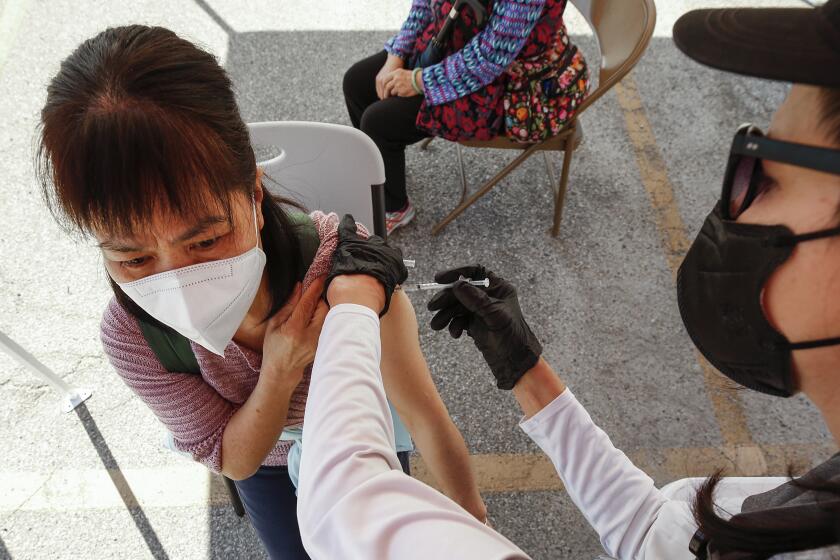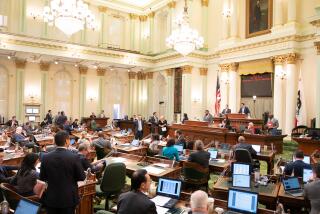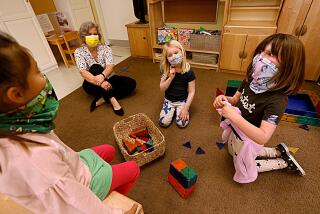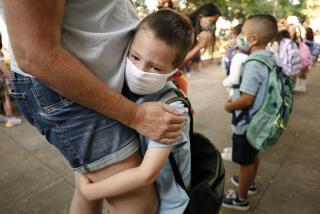Newsom, legislators strike deal to offer schools $2 billion in incentives to reopen campuses

Gov. Gavin Newsom and Democratic legislative leaders announced an agreement Monday to give school districts $2 billion to open schools for students in transitional kindergarten through second grade by April 1.
Gov. Gavin Newsom and Democratic legislative leaders announced an agreement Monday to give school districts $2 billion to open schools for students in transitional kindergarten through second grade by April 1, focusing on California’s youngest children after almost a year of distance learning.
The plan, detailed in Assembly Bill 86, provides financial incentives to school districts that offer in-person instruction at the beginning of next month in counties with fewer than 25 new daily confirmed coronavirus cases per 100,000 residents, a threshold almost all California counties currently meet as the winter’s rapid spread of the virus slowed.
School districts in counties in the state’s red tier, with seven or fewer cases per 100,000 residents, would be required to extend classroom learning to all elementary school students and at least one grade of middle or high school in order to access all available funds.
But the proposal, expected to receive passage in the Legislature on Thursday, stops short of mandating that schools across the state must reopen. Instead, it leaves the final decision to local education officials and, in some areas, subject to agreements between districts and the unions representing school employees.
Parents would also retain the right to have their children continue to learn virtually if they choose.
“I look forward after that vote on Thursday to quickly signing this and moving forward to celebrate the reopening for in-person instruction of schools all up and down the state of California,” Newsom said during an event at a school in Elk Grove, a suburban Sacramento community where campuses were some of the first to close last year.
The deal marks the completion of weeks of negotiations at the state Capitol and a compromise that merges current public health guidelines with earlier school reopening proposals introduced separately by the governor and lawmakers. Newsom has been under increasing pressure to speed up the return to in-person learning and stem the frustration among a powerful voting bloc of parents as he faces the prospect of a recall election later this year.
A group of parent advocates, Open Schools CA, called the reopening plan a “failure” for not opening all schools sooner.
For Newsom, the proposal envisions students back on campus a full two months later than he had promised in the plan he offered in late December. Lawmakers objected to his original effort’s requirement that schools submit lengthy applications for the money and balked at some of the early details over community public health standards.
But the fiercest debate over reopening more school classrooms centered on whether to promise COVID-19 vaccinations to educators. Newsom, who initially resisted new guarantees, relented last month and set aside 10% of the state’s weekly vaccine doses for child-care and K-12 staff beginning this week.
Public health officials said Monday that the state is on course to surpass Newsom’s initial estimate of providing at least 75,000 weekly vaccine doses. And Los Angeles Unified School district officials have announced they expect enough vaccinations to reopen campuses by mid-April — although that time frame depends on an agreement with the teachers union.
The L.A. school district will get the COVID-19 vaccines by the end of the week, with a target of mid-April to reopen some campuses.
The legislation says vaccinating teachers and staff is not a precondition for a district to return to in-person learning, a mandate demanded by the California Teachers Assn.
Union leaders also failed to block Newsom’s push to broadly reopen schools in counties in the state’s most restrictive purple tier. State officials are expected to update the tiers Tuesday. As of last week, all but two California counties had case rates that would allow students in transitional kindergarten through second grade to return to their classrooms.
California Teachers Assn. President E. Toby Boyd said the proposal moves teachers and schools one step closer to resuming in-person education.
“From Day One, our priority has been the safety of our students, their families, educators and school staff,” Boyd said in a statement. “Today’s proposed agreement includes the multi-tiered safety measures educators have been calling for.”
State legislators pushed for the bill to reinforce the state Department of Public Health guidance on testing. The legislation says districts that reopen schools in counties that are in the state’s purple tier will be required to test students and staff who do not have symptoms on campuses without any reported cases. But it allows districts to avoid that requirement if by March 31 they adopt a plan to return to the classroom, or if they already offer in-person elementary instruction. Schools that open in the red, orange and yellow tiers are not required to do the additional testing.
The California Federation of Teachers said it intends to work with local districts to “build upon the testing framework laid out by the state” and had hoped to see more safety enforcement in the bill. The proposal includes $25 million for a “Safe Schools for All Team” under the state public health department that will be responsible as of March 15 for conducting safety reviews of schools with two or more outbreaks.
“Despite the lack of statewide enforcement, teachers and school staff will work closely with districts and counties to ensure compliance with state guidelines,” California Federation of Teachers President Jeff Freitas said in a statement.
The plan relies on financial incentives to get more campuses to open in the spring. School districts in counties that meet the virus case threshold and do not open by April 1 would lose 1% of their share of the $2 billion in reopening funds for each school day that distance learning is the only option that’s offered — a penalty pushed by lawmakers. Schools that are currently open or have plans to reopen before the end of March would be allowed to go forward with their respective reopening and still qualify for the funding.
The $2-billion price tag for getting more California school campuses open was set in Newsom’s original December proposal. In addition, the governor has urged lawmakers to take early state budget action to set aside an additional $4.6 billion for students to receive extra help into the summer to mitigate the shortcomings of distance learning.
The final legislation deviates from earlier proposals that made a district’s school safety plan subject to union approval, a provision that some worried could require local parties that had already reached agreements to return to the negotiating table, slowing down a return to the classroom. By omitting any mention of agreements with unions, the state leaves bargaining subject solely to existing state law and local decision-making.
“It looks to me like they have dismantled every major impediment to reopening schools that can be done at the state level,” said Kevin Gordon, a lobbyist who works with school administrators. “So now the pressure lands at every schoolhouse door.”
The push to reopen many California elementary schools in the next few weeks is the first real statewide effort to do so during the current academic year. State officials only recently released a survey of public and private schools that offers a partial glimpse at how many have remained in full-time distance learning. The data showed no more than half of the districts reported some school sites offering classes on campus.
The state also has not provided a comprehensive look at COVID-19 cases reported in those classrooms. Newsom didn’t offer a clear explanation about that data when asked about it Monday. Later in the day, his administration said the data would be released by mid-month.
More to Read
Start your day right
Sign up for Essential California for news, features and recommendations from the L.A. Times and beyond in your inbox six days a week.
You may occasionally receive promotional content from the Los Angeles Times.









